Stinging nettles are mineral rich, anti-inflammatory and exceptional at supporting the body’s own healing super powers. They can be found all over North America where the moisture levels are right. Nettles prefer dappled sun and are found on the edges of the woods, near moist, damp conditions, with ample fertility. Tap into these stinging nettle benefits for fast relief of seasonal allergies and inflammation.
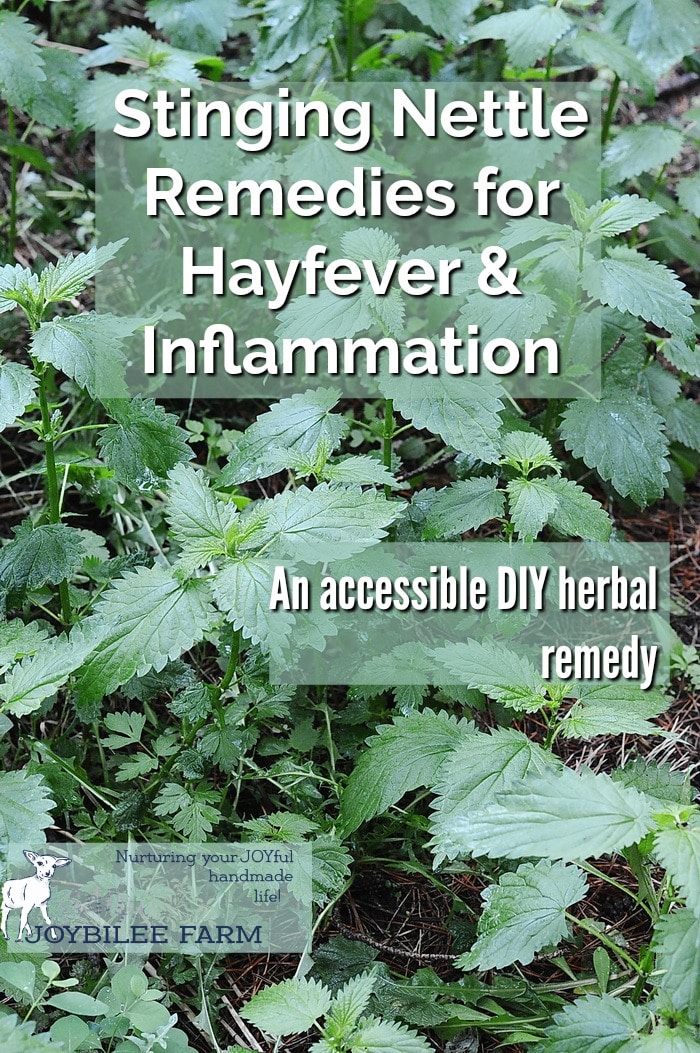
I’ve been outside a lot this week getting the garden ready to plant for spring. Our last frost date isn’t usually till June 10th or so, but a lot of our vegetables and herbs can already be planted. In preparation for this we are adding new garden beds in an area that was once the sheep winter paddock. Can you say “weeds” er I mean medicinal herbs? That’s right. There’s lots of nettles, dandelions, mullein, and even mallow and burdock.
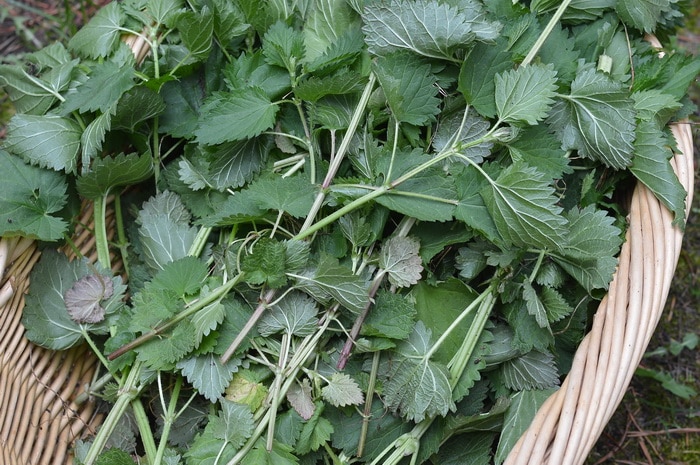
Yesterday Robin came in with a gift. A whole laundry basket full of stinging nettles. Yes, he picked them and even got a few stings, because he knew how thrilled I’d be with so many good nettles. These were a bit longer than the ideal spring greens but they still worked for “spinach” for dinner. It just meant wearing thick rubber gloves and removing the leaves from the stems before cooking them.
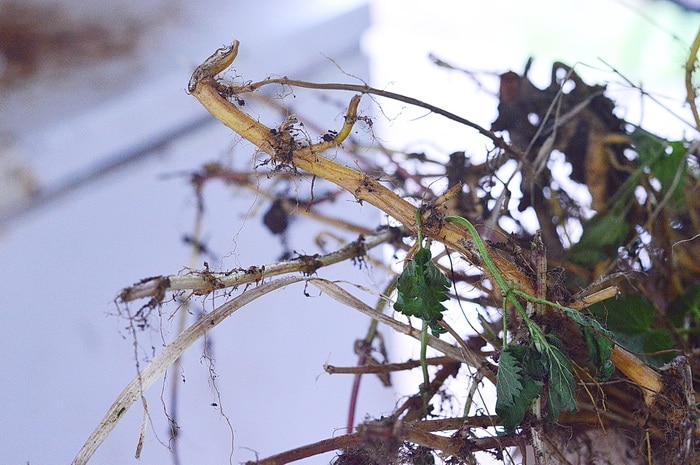
Once I put aside the dinner leaves, I washed them and put more leaves in the dehydrator on low, for winter use. I also set aside the stinging nettle roots for a manly tincture. Stinging nettle root extracts can prevent prostate enlargement and are prescribed in Europe in the European pharmacopoeia for benign prostatic hyperplasia (BPH). They are also prescribed for PCOS.
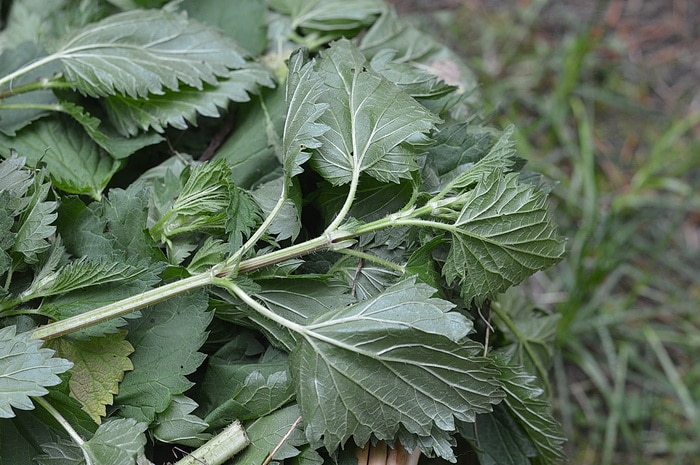
Stinging Nettle Health Benefits
The stinging nettle plant (Urtica dioica) has many health benefits. The leaves are an important nutritive herb. It has vitamin A, vitamin C, and vitamin K, as well as a complement of B vitamins. Nettles are rich in minerals, especially magnesium, calcium, potassium, phosphorous, manganese, copper. They are also rich in chlorophyll and beta-carotene, lutein, and other carotenoids. Tea made from nettle leaves is a useful diuretic, detoxifier, and anti-inflammatory. It is recommended for eczema to help detoxify the liver and help the skin heal.
Stinging Nettle Herbal actions:
Anti-inflammatory, anti-septic, mild hypoglycemic, diuretic, anti-hemorrhagic, hemostatic, detoxifier, vasodilator, circulatory stimulant, hypotensive, nutritive, galactagogue, astringent, expectorant, anti-allergic, reduces BPH, anti-rheumatic.
Stinging nettle can lower blood pressure, lower blood sugar levels, act as a diuretic, reduce pain and inflammation, halt the enlargement of the prostate, detoxify the liver, and help with allergy symptoms.
Use caution if you are taking prescription drugs or are pregnant
Speak to your primary care provider before you use stinging nettle extract if you are taking blood thinners, high blood pressure medication, diuretics (water pills), diabetes medication, or lithium. Stinging nettle could interact with these drugs, enhancing their effect, since stinging nettles has these actions as well.
Stinging nettle tea is sometimes recommended for pregnant women in the last trimester of pregnancy, because it is high in vitamins and minerals. But it may act on the uterus and may cause uterine contractions in some women or even miscarriage. Pregnant women should discuss stinging nettle use with their midwife before using stinging nettle preparations during pregnancy.
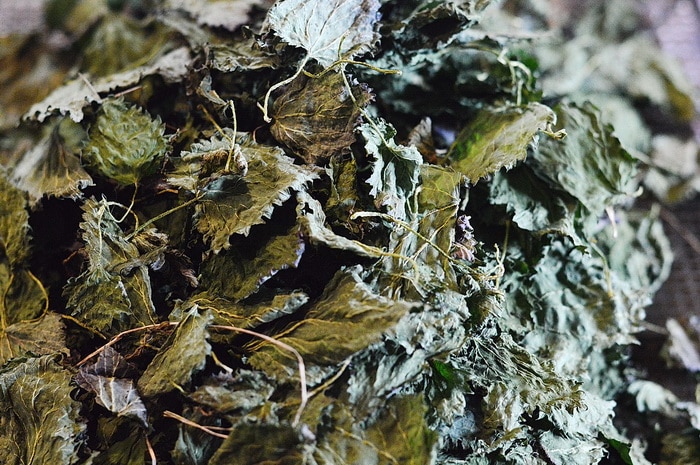
What makes stinging nettles sting?
A lot of people meet stinging nettle in the garden or in the woods by brushing against the tiny hairs or trichomes on the leaves and stem. This may cause a mild rash. When you lightly brush the hair it breaks off in your skin and the stiffened hair injects chemicals like histamine, formic acid, acetylcholine, and serotonin, causing allergic reactions like burning, itching, and a blistered rash.
Why would you want to use stinging nettle as an herbal remedy?
Fresh nettles have natural histamine that binds to the histamine receptors in your body and block their response. So by making an extract of the fresh leaves of stinging nettle these same chemicals can be harnessed to prevent other allergic reactions like hives, or hay fever, calming down the body’s histamine responses. Stinging nettle benefits are quite powerful. This remedy has been compared to over the counter allergy relief.
Stinging Nettle Tincture for Hay Fever
A tincture made with the FRESH leaves has anti-inflammatory and antihistamine benefits and is useful for spring allergies. This is also useful for inflammation and joint pain from over-doing it in the garden. If you don’t have stinging nettle handy, there are other herbs that can help too.
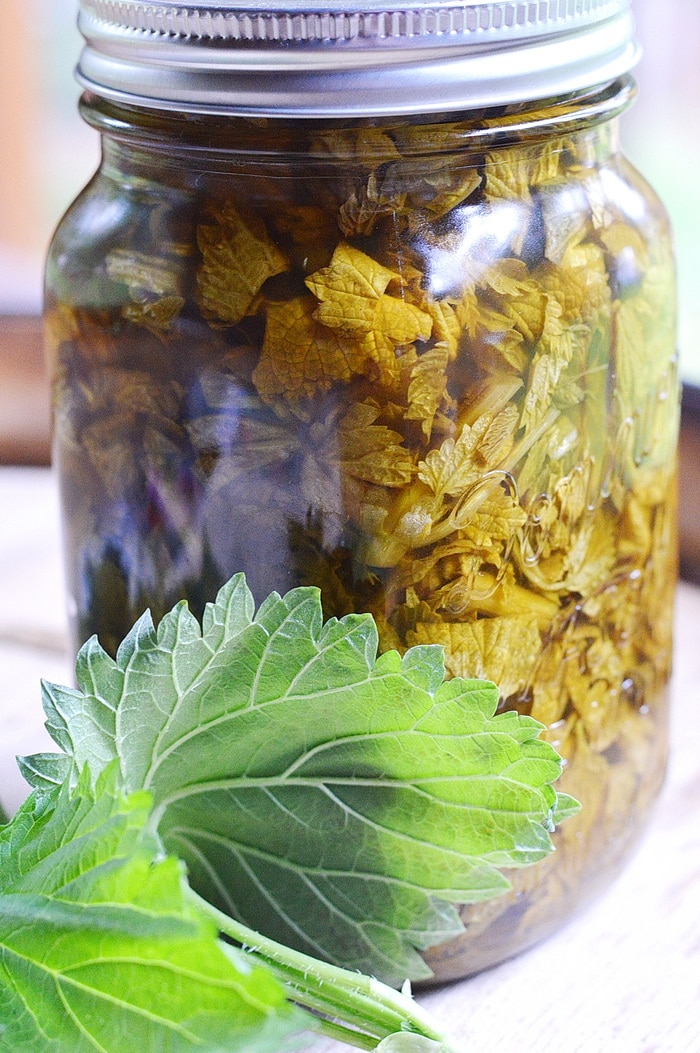
To make this natural stinging nettles allergy remedy:
Fill a quart jar with 4 cups of fresh nettle leaves, chopped. (wear gloves when you prepare them.)
Add 1/4 cup local bee pollen
Pour 3 cups of brandy or vodka over the top.
Cap tightly. Place in a dark cupboard. Shake the bottle as often as your think of it. Steep for 30 days. Strain.
Bottle in an amber glass bottles. Shelf life: 1 year.
Serving size:
- 1/2 to 1 teaspoon 3 times daily for adults;
- 1/4 to 1/2 teaspoon 3 times daily for children 6 to 12.
- 5 drops to 10 drops, 3 times daily for children 2 to 5
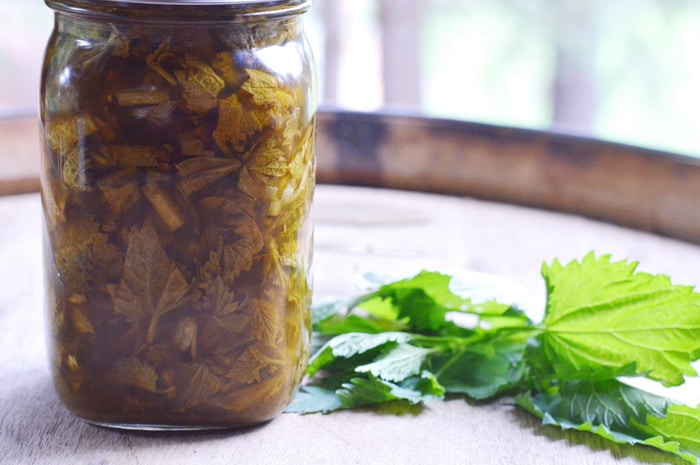
Nettle Salve for Arthritis and Joint Pain
A salve made by infusing dried nettle leaves in a carrier oil like sweet almond oil or extra virgin olive oil, is scientifically demonstrated to relieve joint pain and arthritis inflammation. Use 7 parts infused oil to 1 part beeswax to make the salve.
Yield: 4 ounces
- 7 tablespoons Nettle Infused Olive Oil
- 1 tablespoon beeswax
Directions:
Make a double boiler using a glass measuring cup. Place the ingredients inside the glass measuring cup.
Simmer over medium heat until the beeswax is melted. Stir to combine. Pour in salve tins. Allow to cool naturally. Complete lids. Label and date.
To use:
Apply to sore joints and inflammation, as needed.
A word of warning: Stinging nettle leaves have tiny hairs. When the plant is fresh those hairs act like hypodermic needles injecting your skin with formic acid. But once they are dry the pain of the sting is gone. Conventional wisdom says they can be safely handled with bare hands. However, the tiny hairs remain. Use gloves when stuffing dried nettles into jars. The irritating hair can trigger burning sensations even if the uticaria rash doesn’t happen.
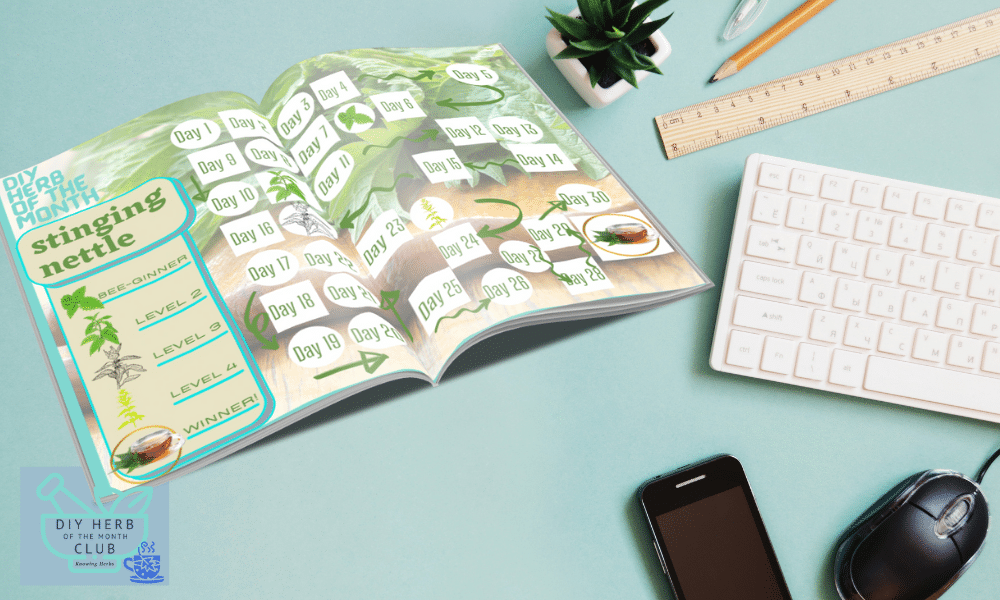
Get to know your herbal allies by studying one herb at a time
Stinging Nettles is one of the herbs that we study in the DIY Herb of the Month Club. In the Herb of the Month Club our members take a 30 Day journey to get to know one herbal ally better each month. Every month members study one herb in detail, in a way that engages all their senses, building their herbal confidence, through hands on learning. Each month is a different herb, so you build your herbal knowledge quickly and with intention. If you are ready to dig deeper into your herbal allies and their benefits…
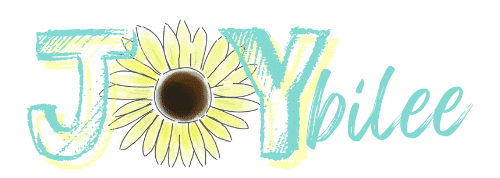
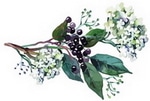
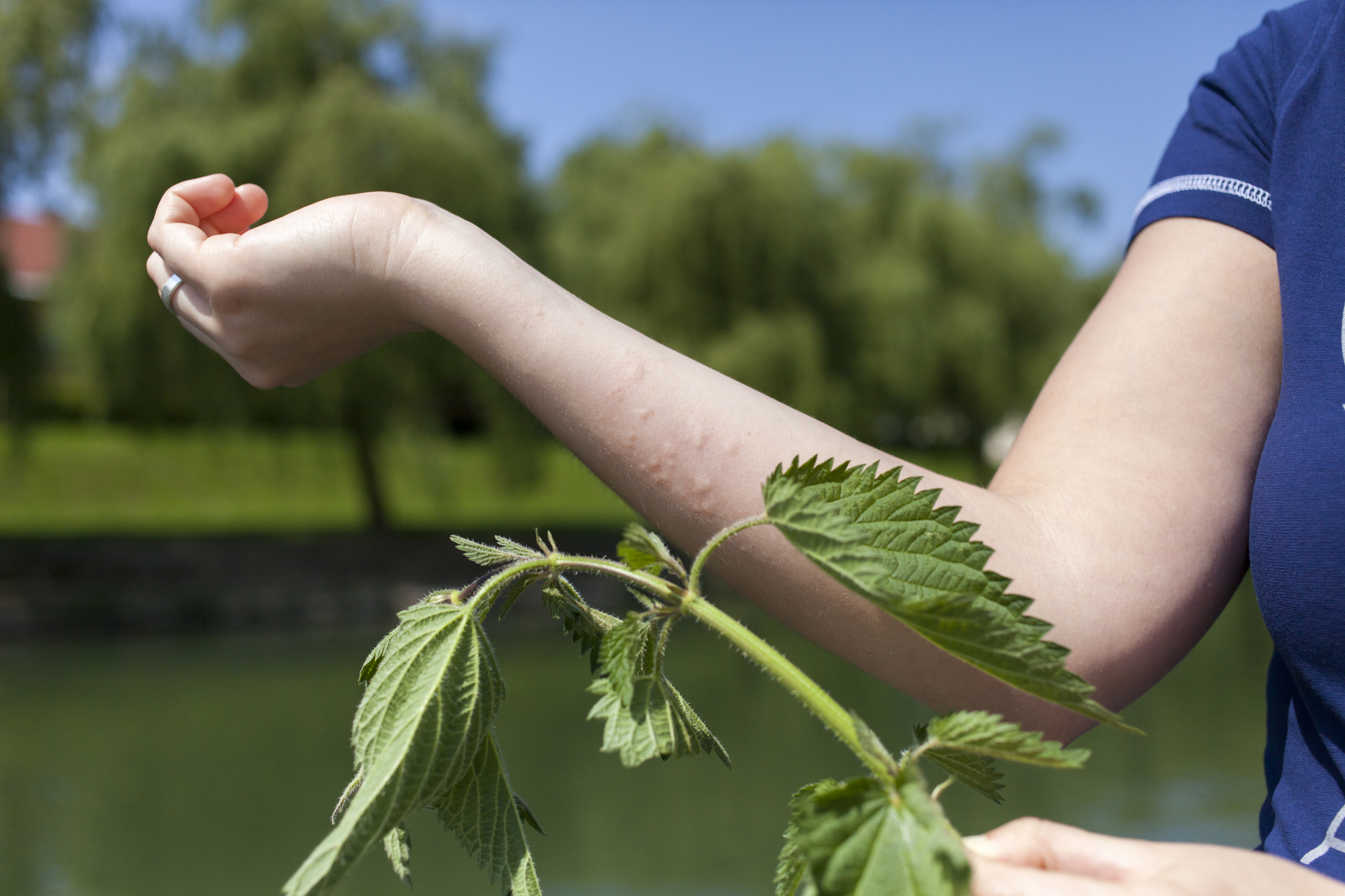
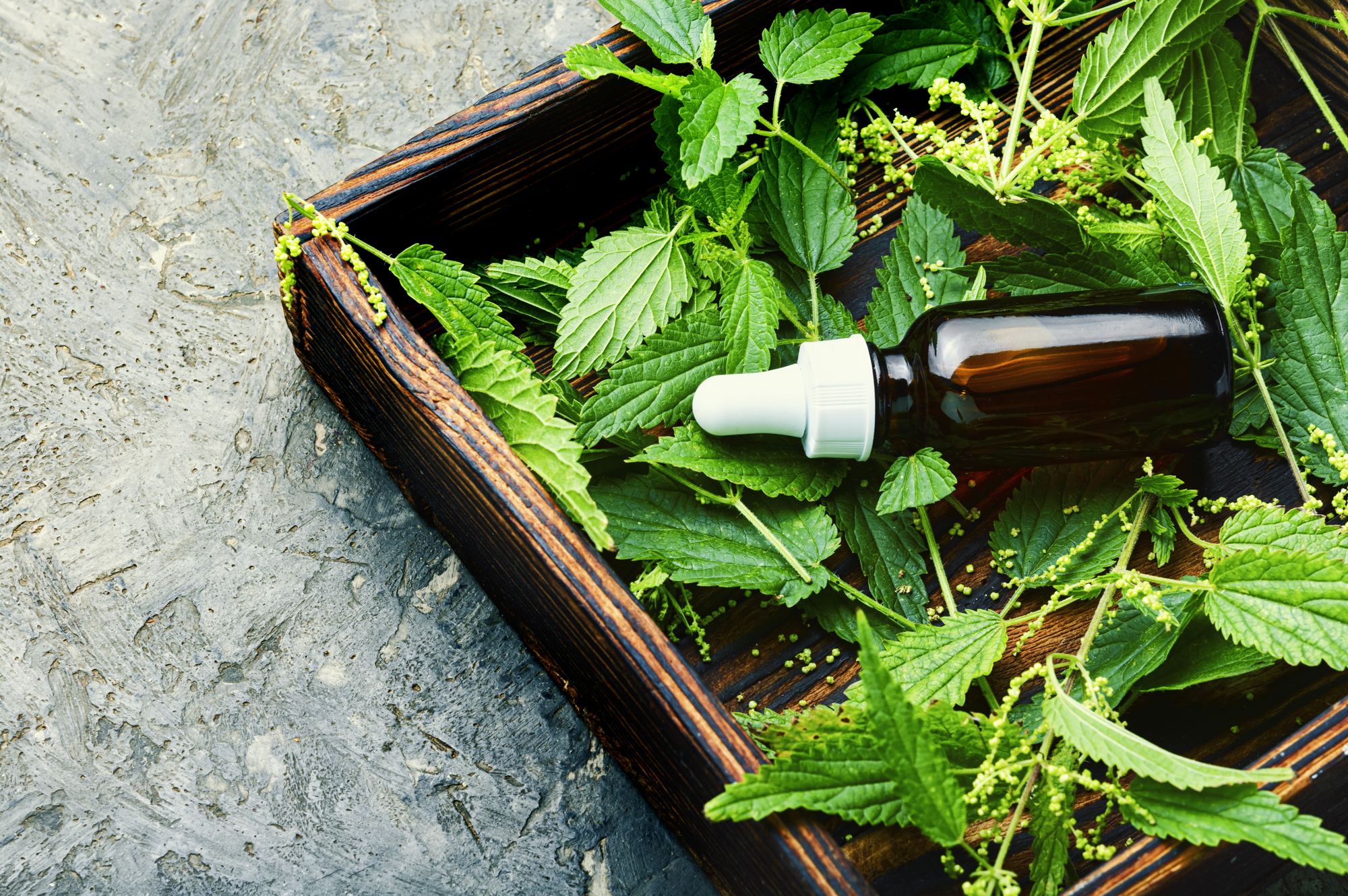

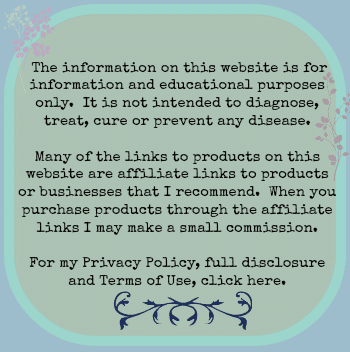
Thank you!Awesome Info/I really appreciated!
My husband got stinging of a poison that brought us to scary experience of allergen reaction
He use drops of licorice ( 5 star anise tincture ) every 5 minutes 10 drops under the tongue total 4 times
Then strong tea of Urtica Dioca add ice cubs to help cool down the Hay FEVER
He was in Panic and Itching and Burning skin was raising up very swollen
He use topic Spray apple cider vinegar diluted in 50%water
Make a cream Mix to apply on top of the skin with one tube of hidrocortisone plus 2 pills of ZINC 50mg crushed to powder
Sundenly went away like a miracle
I do attribute that Netles tea STOP that ungry Stamine reaction (30minutes)
Is very good take action fast , this was a life save. Blessings
Hi, Shaz. I generally recommend making a glycerite for children under 12, if the supplement will be used daily. Those are a lot of supplements for a seven year old. It might be helpful to remove as much of his allergens as possible before supplementing so that his body has a rest from the allergen triggers. It can be helpful to work with a clinical herbalist to best way to address some of these issues.